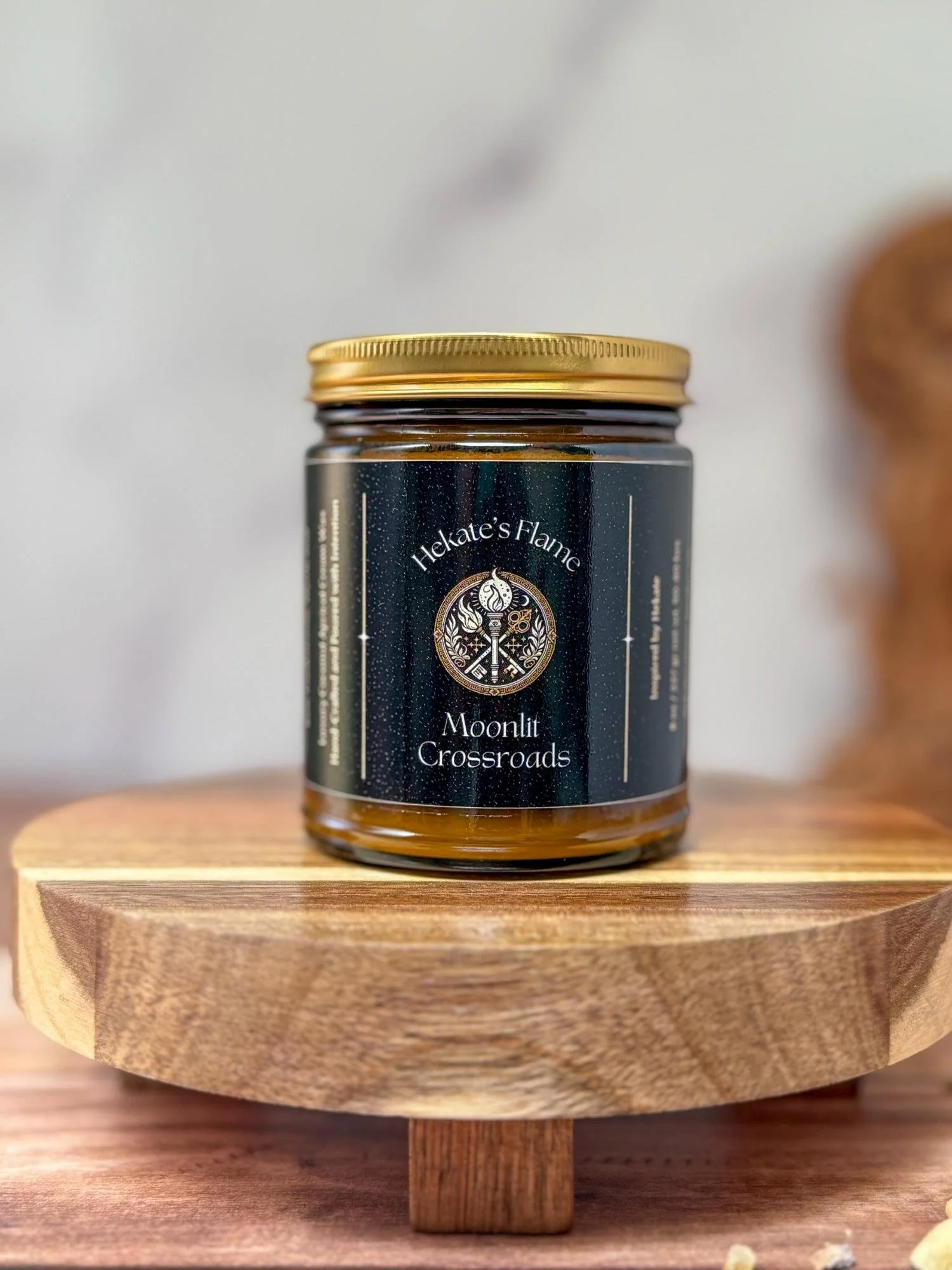‘Wisdom’s Bloom’: a handmade artisanal candle inspired by Athena, the Greek goddess of wisdom, strategic warfare, and crafts
She who sees with the eyes of the owl and guides with the fire of thought
Imagine morning light filtering through olive leaves, the air calm and bright with promise. That is the spirit of Wisdom’s Bloom: bergamot and green leaves fresh as thought itself, honeysuckle, jasmine, and rose unfolding in quiet harmony, and sandalwood with guaiacwood grounding it in steady grace. A scent of clarity and strength, honoring Athena, who guides through insight and courage, and teaches that true power begins within.
Scent Notes:
Top: Bergamot, Green Leaves
Heart: Honeysuckle, Jasmine, Rose
Base: Sandalwood, Guaiacwood
🌿 Season Scent: Spring
🌸 Primary Scent Family: Floral
🌱 Secondary Scent Family: Woody & Earthy
Please visit this blog post for more information on Scent Profiles, Top, Heart, and Base Notes.
Our candles are lovingly handcrafted in our home studio, Nimue’s Lair, nestled in Walnut Creek, CA. Each one begins with a luxurious blend of coconut-apricot wax, carefully infused with premium fragrance oils. Poured by hand into elegant glass vessels and amber jars, they’re finished with hand-cut labels and enchanted final touches. Every candle is a small ritual, infused with magick, intention, and the quiet glow of story.
-
12 oz Deluxe – Amber Aura Glass · Coco Apricot Wax
Burn Time: 60+ hours
Bold and enduring, this candle fills your space with myth and memory. Crafted for spacious sanctuaries, this candle shines in wide-open living rooms, high-ceilinged studios, and sacred hearths ~ places where scent is free to roam and the flame becomes a luminous companion to stillness and story.8 oz Classic – Amber Jar · Coco Apricot Wax
Burn Time: 50–60 hours
A perfect size for quiet corners and thoughtful pauses. Let it warm your reading nook, home office, or bedside altar, where its flame flickers like a whisper of intention.4 oz Petite – Amber Jar · Coco Apricot Wax
Burn Time: 20–25 hours
Small in size, rich in presence. This candle is ideal for travel, gifting, or sanctifying intimate spaces - guest rooms, personal altars, or quiet corners where scent and flame are invited to linger with intention. -
For detailed information about our waxes, wicks, fragrance blends, and vessels, please see our Ingredients & Materials Guide.
-
For guidance on how to tend your flame with care, ensuring the cleanest, safest, and most enchanting burn, please visit our Candle Care Guide.
-
Please visit the Shipping and Returns Information page for details.
-
All photographs, images, and written content on this website are original works of Hekate's Torch Apothecary, LLC (doing business as Hekate’s Flame Apothecary) and are protected by copyright. They may not be used, altered, shared, or reposted on any platform without explicit written consent. All label designs, photos, images, and content are the exclusive property of Hekate's Torch Apothecary, LLC.
For inquiries regarding the use of our content, please contact: care@hekatesflame.com
© 2025 Hekate's Torch Apothecary, LLC. All rights reserved.
Content Warning:
This post explores ancient myths that include themes of violence, including assault and warfare, which may be sensitive for some readers. Please proceed with care and be mindful of your well-being while engaging with these stories.
The myths surrounding Athena are complex and multifaceted, often involving themes that reflect the values and conflicts of ancient Greek society. Below, we explore these stories, probing their cultural significance and how they have been interpreted over time.
Athena, the Greek Goddess of Wisdom and War
Athena is the Greek goddess associated with war, wisdom, and craftsmanship. She is also the protector of cities and is primarily connected to Athens. Unlike Ares, who symbolizes aggression and the brutality of war, Athena embodies a more strategic and defensive approach to warfare, engaging in necessary and deliberate battles rather than impulsive and war-hungry.
As the goddess of craftsmanship, Athena is deeply connected to traditional crafts, such as spinning and weaving. In some depictions, she is portrayed in full armor, yet instead of wielding a spear, she holds a distaff for spinning wool or flax, highlighting her dual role as a warrior and a patron of the domestic arts. Her influence extends to areas like carpentry and metalwork, which she shares with Hephaestus, with whom she is also linked in religious practices.
Athena was deeply involved in her followers' daily lives, providing guidance and support in practical matters. She was credited with inventing the first ship and teaching humanity the art of sailing, establishing a special bond with sailors who relied on her for safe passage. Most notably, Athena was the only deity capable of calming Zeus's wrath and emerging unscathed, a testament to her unique wisdom and influence among the gods.
Athena's Appearance, Symbols, and Sacred Elements
Athena is often portrayed fully armed, donning a helmet and a breastplate adorned with snakes and wielding the aegis, a protective goatskin shield with Medusa's head portrayed on it. The snake and the owl, symbols of wisdom, are sacred animals associated with her. At the same time, the olive tree holds the highest reverence as her most sacred plant.
Athena's Mythological Origins
Whatever it is, the way yThe exact origins of Athena and her name remain uncertain. However, evidence suggests that an early version of her name existed in Greece during the Bronze Age, from approximately 3000 to 1150 BCE. It is also unclear whether the name of Athens, the city most closely associated with her, existed before or after her name came into use.
Athena's Birth Story
The myth of Athena's birth, who would ultimately become Zeus's most cherished child, intertwines with elements from other divine birth stories. Like Uranus (Zeus's grandfather) and Cronus (Zeus's father), who feared being overthrown by their offspring, Zeus too worried that one of his children might eventually usurp him.
According to Hesiod's Theogony, Zeus, following the counsel of Gaia and Uranus, decided to swallow Metis, the Titan goddess of wisdom and foresight, after she became pregnant with his child. His intention was twofold: to prevent the birth of a potentially more powerful and wise child and to keep Metis's wisdom for himself.
However, this act causes Zeus to suffer a severe headache, and when Hephaestus splits his head open with an axe, Athena emerges fully grown and fully armed from the wound.ou tell your story online can make all the difference.
Athena's Role in Mythology
Athena, the Virgin Goddess of Good Counsel
In many myths, Athena is often portrayed in contrast to Aphrodite, embodying reason in opposition to passion and wisdom in contrast to beauty. As the protector of Athens, Greece's first city, Athena came to symbolize the values most cherished in Greek culture. Stories about her frequently highlight her embodiment of intelligence, self-discipline, and wisdom. She is steadfast in her commitment to chastity, remaining unaffected by the emotions of love or desire.
However, Athena did have a child, though not in the conventional sense. Hephaestus desired to marry her, and when she rejected him, he attempted to force himself upon her. Athena thwarted Hephaestus but had to clean herself with a tuft of wool, which she discarded onto the earth. From this act, Erichthonius, a being with the body of a man and the tail of a serpent was born.
Although Athena did not bear Erichthonius herself, she assumed responsibility for him, overseeing his upbringing and education and ultimately establishing him as the king of Athens. After his death, she transformed him into a star within the constellation Auriga, the charioteer.
Athena, the Patroness of Heroes
Athena is renowned as a guardian and protector of heroes.
Among those she aided were Jason, leader of the Argonauts in their quest for the Golden Fleece; she defended Orestes, who avenged his father's death by killing his mother, Clytemnestra; Theseus, who defeated the Minotaur and became the king of Athens; Herakles (known as Hercules in Roman mythology); and the cunning Odysseus (Ulysses in Roman tradition), whose arduous ten-year journey home after the Trojan War is famously chronicled in Homer's Odyssey.
Among Athena's favored heroes was Perseus, the son of Zeus, and a mortal woman, Danae, which naturally stirred Hera's deep sense of betrayal and jealousy. Despite the complex dynamics within the divine family, Athena chose to protect and guide Perseus on his perilous quests. When he embarked on the mission to slay Medusa, the terrifying Gorgon with snakes for hair, Athena lent him her magical shield. Perseus wisely used the shield as a mirror, avoiding Medusa's deadly gaze that could turn a person to stone. Upon returning triumphant, Perseus offered Athena the shield and Medusa's head. In artistic representations, Medusa's head often adorns Athena's shield, breastplate, or helmet.
Athena's Wrath and Ovid's Portrayal of Athena as Internalized Misogyny
Ovid's Story of Medusa and Athena
When Ovid wrote his Metamorphoses in the first century AD, he recounted more than 200 myths, with the tale of Medusa standing out as one of the most renowned.
There are three key points to consider about Ovid's work:
First, his retellings are often more embellished than those of earlier poets and historians.
Second, Ovid wasn't particularly fond of the gods, and he frequently portrayed them in a negative light when given the opportunity.
Third, being Roman, Ovid had a different perspective on certain gods than the Greeks did, favoring Ares (Mars) over Athena (Minerva), for instance.
Ovid was among the first to depict Medusa as entirely human, a young maiden distinct from her monstrous sisters. In his version of the myth, Poseidon tries to seduce Medusa, and when she resists, she seeks sanctuary in one of Athena's temples. However, Poseidon pursues her inside and violates her, regardless of her attempts to escape. Witnessing the desecration of her temple, Athena becomes enraged, not at Poseidon, but at Medusa.
As a result, she punishes Medusa by transforming her into a monster with snakes for hair, dooming her to a life where any man who gazes upon her is turned to stone. To further add to her misery, Medusa is then exiled and condemned to live in isolation.
The primary issue with Ovid's version of the Medusa myth is that it's the only account that includes this specific interaction between Medusa and Poseidon. This version also portrays Athena in a way inconsistent with other Greek poets' and historians' depictions. While Poseidon's actions are typical for his character, Ovid's account suggests that Athena was jealous of Medusa's beauty and acted out of pettiness and irrationality, traits not commonly associated with her in Greek mythology. This negative portrayal of Athena, or Minerva as the Romans called her, is a recurring theme in Ovid's works, such as in the story of Athena and Arachne (discussed below.) This suggests that Ovid had a particular bias for Athena, which aligns with the Roman preference for Mars (Ares) over Minerva (Athena).
In contrast, earlier Greek depictions consistently show Athena as one of the most level-headed, rational, and respected deities in the pantheon, a reputation that wasn't hard to maintain given the nature of the gods. Perhaps in response to Ovid's version, some Greek sources adapted the ending of the myth to suggest that Athena's transformation of Medusa into a Gorgon was an act of protection rather than punishment. This version suggests that Athena could not always watch over Medusa, so by transforming her into a Gorgon, she ensured that no man could ever harm her again.
There are also Greek stories where Athena punishes Medusa for her hubris, particularly for comparing her beauty to that of the gods, a classic case of hubris leading to a downfall. In this interpretation, Medusa's transformation serves as a lesson: those who boast about their beauty, especially compared to the gods, risk having it taken away.
Ovid's Story of Arachne and Athena
Ovid's critical portrayal of Athena continues in the story of Arachne, a skilled weaver who, driven by hubris, dared to challenge the goddess to a contest. Despite warnings, Arachne boldly depicted both the triumphs and the flaws of the gods in her tapestry. Enraged by the young woman’s audacity and the truths revealed in her work, Athena destroyed the tapestry and punished Arachne by transforming her into a spider, ensuring that her weaving would continue but in a form far removed from her previous human glory.
Hubris in Ancient Greek Culture: The Dangers of Excessive Pride and the Consequences of Defying the Gods
In ancient Greek culture, hubris was considered one of the most dangerous and destructive human traits. It referred to excessive pride or self-confidence, especially when it led individuals to defy the gods or disrespect social norms.
Hubris often resulted in severe consequences, as it was believed to provoke the wrath of the gods and lead to a person’s downfall. This concept is central to many Greek myths and tragedies, where characters who exhibit hubris often suffer tragic fates, serving as a cautionary tale about the dangers of overstepping one's bounds and the importance of humility.
Athena's Contest for Athens
Athena was revered as the patron goddess of Athens, with her majestic temple, the Parthenon, standing prominently atop the city's rocky heights.
She earned this esteemed position as a reward for her wisdom and benevolence towards humanity. In ancient times, Cecrops, the king of Attica, played a pivotal role in uniting the region's tribes to form a city-state. Observing from Olympus, the gods recognized that this emerging city would become one of the most significant in the world. Naturally, many gods vied to be the city's protector, leading to a fierce debate over who deserved this honor.
Eventually, it became clear that the two strongest contenders were Poseidon, due to the city's proximity to the sea, which was his domain, and Athena, whose influence over the arts and civilized life promised prosperity.
Neither deity was willing to concede to the other, causing even Zeus to worry about the potential conflict between two such powerful Olympians. To resolve the matter, Zeus proposed a contest, judged by the other gods, where each deity would present a gift to humanity, something useful and beautiful, and the deity with the finest creation would be granted patronage over the new city.
Poseidon struck the ground with his trident, conjuring a powerful, graceful horse, the first of its kind. Other sources describe how his trident created a surge of water from the fissure.
Despite the grandeur of his gesture, the seawater he produced held little value for the Athenians, who already had access to abundant rivers and were located near the sea.
The gods were impressed and believed the contest might be decided, but Athena calmly brought forth an olive tree from the rocky earth. She explained that the olive would provide sustenance for people and oil for offerings to the gods. The tree was hardy, enduring even in harsh conditions, and, most importantly, symbolized peace, in contrast to the horse, which symbolized war. Peace, she argued, was more beneficial and beautiful for humanity than war.
As the city's prosperity grew, so did her prestige, and as Athens rose to become the foremost Greek city, her status among the Olympians elevated accordingly.
Athena's Many Names and Epithets
Like other Olympian deities, Athena was known by various names or epithets, each reflecting different aspects of her role, regional variations, or specific elements of her worship.
The most common of these is Pallas Athena. This name originates from her battle with Pallas, the son of Uranus and Gaia, during the Titanomachy. After defeating and killing him, she wore his skin as a trophy, symbolizing a blend of his strength with her wisdom.
Another version tells of Pallas being the daughter of the sea-god Triton and a close childhood friend of Athena. During a friendly sparring match between the two, Zeus, not wanting Athena to lose, distracted Pallas by shaking his aegis. As a result, Athena accidentally struck and killed her friend. Devastated by what she had done, Athena adopted the name Pallas as a way to honor her fallen companion, and Zeus, in a gesture of apology, gave her the aegis. As Pallas Athena, she was often depicted with an owl companion, a symbol of wisdom, while as a fierce warrior, she was crowned with a crest of snakes.
Athena was also referred to as Parthenos, a title meaning "virgin" in Greek, honoring her steadfast commitment to chastity. As Athena Parthenos, she was portrayed seated on a throne, fully armed with a shield and spear.
Other epithets included Glaukopis, which referred to her striking bluish-grey eyes, and Hippia, meaning "horsewoman," acknowledging her role in teaching humans to harness horses.
The name Coryphagenes, or "born from the head," relates to her unique birth from Zeus's forehead. She is also known as Ergane ("Craftswoman" or "Maker"), Nike ("Victorious"), Promachos ("Champion in the Front Lines"), Polias or Poliouchos ("Protector of Cities.")
References:
Hamilton, E. (2017). Mythology (75th Anniversary Illustrated Edition): Timeless Tales of Gods and Heroes. Hachette UK.
Illes, J. (2010). Encyclopedia of spirits: The ultimate guide to the magic of fairies, genies, demons, ghosts, gods & goddesses. Harper Collins.
Littleton, C. S. (2002). Mythology: the illustrated anthology of world myth & storytelling. Duncan Baird.
Monaghan, P. (2014). Encyclopedia of goddesses and heroines. New World Library.
Spretnak, C. (1992). Lost goddesses of early Greece: A collection of pre-Hellenic myths. Beacon Press.






I begin to sing of Pallas Athene, the glorious goddess, bright-eyed, inventive, unbending of heart, pure virgin, savior of cities, courageous, Tritogeneia. From his awful head wise Zeus himself bare her arrayed in warlike arms of flashing gold, and awe seized all the gods as they gazed. But Athena sprang quickly from the immortal head and stood before Zeus, who holds the aegis, shaking a sharp spear: great Olympus began to reel horribly at the might of the bright-eyed goddess, and earth round about cried fearfully, and the sea was moved and tossed with dark waves, while foam burst forth suddenly: the bright Son of Hyperion stopped his swift-footed horses a long while until the maiden Pallas Athene had stripped the heavenly armor from her immortal shoulders. And wise Zeus was glad. And so hail to you, daughter of Zeus, who holds the aegis! Now I will remember you and another song as well.
































































































